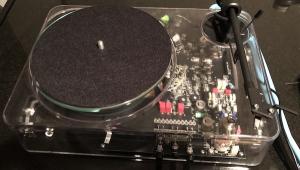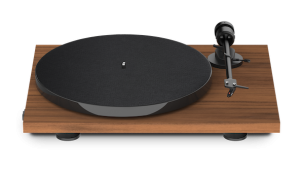Pro-Ject’s T2 Super Phono Turntable Is a Super Performer, and It’s a Super Bargain Too

Pro-Ject Audio Systems, a cornerstone in the turntable industry alongside Great Britain’s royal Rega, boasts a rich heritage spanning decades. Few audiophiles can claim a listening journey untouched by Pro-Ject’s influence — we here at AP included.
Me, I’ve personally assessed the Pro-Ject Debut Carbon EVO, owned the RPM 9 Carbon, and yearned for the upper-crust Signature 10. Given the connective tissue between Pro-Ject and Music Hall — Pro-Ject’s owner/founder Heinz Lichtenegger’s Audio Tuning manufactured Music Hall, and I have also reviewed the latter’s MMF-7.3 table — this proximity has forged a particular admiration for the brand. Not quite a fanboy, mind you, but a believer — and thus, I was quite eager to see what Pro-Ject’s T2 Super Phono turntable, which is billed as the company’s “Audiophile Entry Level Turntable” with a quite reasonable entry-point SRP of $649, could do.

Features & Specs
Pro-Ject’s T2 Super Phono belt-drive turntable comes with a pre-aligned Sumiko Rainier moving magnet (MM) cartridge (available separately for $149), 9in aluminum tonearm, built-in MM phono preamp, three cushy feet, and a pair of clear, rubber-shielded, gold-plated one-meter RCA interconnects.
Furthermore, the Austrian-made T2 Super Phono table boasts a sleek, lightweight design featuring a 10mm thick, 1.7kg tempered-glass platter. Additional highlights include a spring-based anti-skating mechanism, nickel-plated counterweight, electronic speed control for both 33⅓ and 45rpm, and the usual acrylic dust cover with adjustable hinges. (Never spin any record with that resonance-producing thing in place, btw.) Choose from glossy black, satin white, or walnut finishes to complement your style and listening room space. (As you can see, the T2 Super Phono table I’m reviewing here is glossy black.)

Though entry-level, the T2 table sports a familiar-looking Pro-Ject tonearm and ¾-in CNC-machined plinth (no doubt made from MDF), all contained in a slightly oversized overall footprint — 18 x 5.27 x 13in (w/h/d) — that, along with Pro-Ject’s vaunted trickle-down technology, separates it from the typical new-turntable-purchase contenders in this price range.
Under the hood, as it were, the T2 Super Phono, which weighs 12lb, is designed and manufactured with an eye to eliminating “resonant hollow” spaces, the idea being to eradicate internal standing waves, disrupt resonances, and generally provide a better launch pad for the booty of your vinyl habit. Eliminate — or at least disrupt — noise/resonances, and you’ve gone a long way in actually hearing what is buried deep in the grooves of your latest Tone Poet LP acquisition and/or those classic Fleetwood Mac and Led Zeppelin 12in platters.
An upgrade from the Pro-Ject T1 (though its plinth seemingly remains the same), the T2 “boasts a construction free of plastic components,” as implored by the Pro-Ject site, where the T2 Super Phono lands between the basic T2 without a phono preamp, and the Wi-Fi-equipped T2 W.
“Furthermore,” continues the company site,” the glass platter in the T2 has been made heavier and thicker compared to its predecessor, ensuring a zero-resonance design that effectively eliminates the shortcomings associated with plastic or lightweight steel alternatives.”

You want specs? I got specs. Speed variance is 0.6% for 33⅓rpm and 0.5% for 45rpm; wow and flutter is 0.19% at 33⅓ and 0.17% at 45rpm; and S/N is 67dB.
Not surprisingly, at this price point, I found no way to adjust VTA or azimuth. However, proving this is not your grandma’s cheap entry-level LP spinner, Pro-Ject takes advantage of their place in the market by offering a sturdy plastic subplatter that sits atop a 0.001mm main bearing extending to a steel axle with a brass bushing. This, along with its solid tonearm, precisely machined plinth, and onboard phono preamp, makes the T2 Super Phono perhaps the table to beat in its price range.
About that defeatable phono preamp — it’s a “split-passive” MM version. In Pro-Ject’s explanation, the high-pass and low-pass sections of the RIAA EQ curve are split into separate circuits. “This is more expensive to implement,” stated Jeffrey Coates, director of Pro-Ject Audio USA, “but ultimately delivers closer matching to the RIAA EQ curve and more accurate playback of the music on the record.”
The Pro-Ject site further confirmed, “Because of the additional PCB space we have on the T2 Super Phono, we were able to improve the design and layout a notch, which gives the T2 Super Phono even more fighting power for longevity and audio performance.” Honestly, I’ve never heard an onboard phono preamp I’ve liked, but let’s give this one the benefit of the doubt.

Setup
The T2 Super Phono table’s spring-loaded anti-skate system does away with the conventional weight-on-a-string approach — hallelujah! By the way, I may tend to agree with VPI’s Harry Weisfeld, who believes that anti-skate is largely unnecessary if all other elements of a tonearm are dialed in correctly. That said, I set anti-skate to the Sumiko Rainier’s suggested tracking force of 2g, and moved on.
Beautifully, carefully packaged, and thanks to a clear, nicely illustrated, large, and foldable (!) setup page, the Super Phono T2 was a cinch to get into action. My iPhone’s RPM app showed the T2 spinning a tad slow at 32.88. (Better it be a tad slow, which imbues weight, than too fast, which wrecks timing, upsets pitch, and is generally more sonically deleterious.) Confirmed by my Riverstone Audio Gauge, factory-set tracking force was 1.85g, which I boosted to the aforementioned, recommended 2g. Cart-to-tonearm alignment was nearly perfect, however, as confirmed with my Dr. Feickert Analogue Universal Alignment Protractor.

My rig for this review included high-end components not likely to be paired with this kind of table — but, as I’ve stated before, if a budget component can kick butt in an uber-expensive system, imagine the possibilities in its own economic ballpark. My setup included the PrimaLuna EVO 100 phono preamp, Shindo Allegro preamp, Air-Tight ATM-1E power amp, and DeVore Fidelity Gibbon Super Nine loudspeakers. Cables were brought to you by Triode Wire Labs, Auditorium 23, and AudioQuest, and an AudioQuest 707 line conditioner was also in the mix.
Upon seeing the T2 Super Phono, audio buddy and hi-fi missionary Steve Cohen remarked, “That’s the most Rega-looking turntable Pro-Ject has ever made!” Its slim plinth, glass platter, and Rega-esque tonearm certainly fit the bill. But what about the sound?

Listening Sessions
Though lacking the ultimate detail, separation, soundstaging and tonal proficiency of more expensive turntable/cartridge combinations, the T2 Super Phono got to the heart and soul of the music I played — the human pulse that makes music breathe, engage, and immerse. Whether playing jazz, metal, swing, vocals, or Hungarian dance songs, the T2 Super Phono was a blast to spin and experience. It has as much kick, punch, power, and demonstrative abilities as way more expensive machines, and gives up nothing in pure gut-punching, soul-searing, emotion-packed music replication.
The T2 Super Phono table repeatedly surprised me — though its soundstage could be small at times, its lack of absolute separation of singers and instrumentalists was consistently evident. That said, it expressed the gist of music, and of living, breathing, responding-in-the-moment musicians with an uncanny ability to cut across genres and eras. Whether playing contemporary Tool, ’50s-era Buddy Rich, ’70s-era Singers Unlimited, or ’60s-era John Coltrane and Miles Davis, the T2 took a back seat to nothing and no one — and at $649, no less.

The Pro-Ject T2 Super Phono table played with the punch of a direct-drive model, and the assured rhythmic breeziness of a belt-drive. It never sounded stuffy, slow, or lacking in energy — if anything, its sense of rhythmic acuity was one of its strong suits.
I challenged its ability to put-pedal-to-metal or swing like a high-flying bird with a variety of recordings. Tool’s August 2019 2LP set Fear Inoculum (Tool Dissectional 19439868791) sounds like a scrum of old-school creeper metal expressed in high falutin’ modern studio production wrapped in leftovers from Aleister Crowley’s dinner, but I dig it. (Brief sidenote: I once interviewed Tool at their West Hollywood, California rehearsal space, a place that was decorated with an occult library, various Mexican masks, and a larger-than-life Enochian cipher wheel. After the band left for lunch, I asked the studio manager, “Do you ever see or hear anything weird here?” To which he replied, sheepishly, “Late at night, I hear growling.”)
The T2 Super Phono breathed a new spirit into Fear Inoculum, transforming its quieter moments with a subtle plasticity while unleashing a full-on assault on the louder sections. The soundstage was expansive, with each instrument — from Adam Jones’ serpentine guitars to Danny Carey’s gut-punching drums — fully realized. The T2 never faltered under the weight of Tool’s metal intensity, matching their power with precision.

In stark contrast to Tool, Buddy Rich and Harry “Sweets” Edison’s 1955 release Buddy and Sweets (Norgran MGN-1038) showcased a more intimate swing sound. Despite its smaller scale, Rich’s drumming was explosive, filled with intricate stickwork and fiery energy. Edison’s trumpet added a touch of sweetness. While my Thorens TD 124 turntable/Korf tonearm/Ortofon SPU GE MkII cartridge setup offered a larger soundstage and greater sonic authority, the T2 Super Phono delivered the music with equal rhythmic drive and musicality. Fact is, Rich’s searing buzz rolls and triplet patterns were delights to hear on the T2.
The T2 also brought immediate life force to pianist Hampton Hawes’ August 1961 offering For Real! (Contemporary Records S 7589), effortlessly expanding the album’s soundstage and painting vivid portraits of bassist Scott LaFaro, drummer Frank Butler, and tenor master Harold Land. The Pro-Ject table’s performance captured the music’s warmth and energy with solid precision.

Conclusions
The Pro-Ject T2 Super Phono turntable’s ability to accurately convey the unique character of each LP I spun on it was impressive, a quality often lacking in lower-priced tables. Upgrading the cartridge to a moving coil Denon DL-103 (with a suitable SUT — a.k.a., step-up transformer) would likely elevate the experience even further, adding a layer of detail, refinement, and engagement.
Finally, I switched out the PrimaLuna EVO 100 phono preamp for the T2’s onboard preamp, which was enabled by the push of a button on the table’s backside, next to the RCAs. Of course, one can’t logically compare a nearly $3K standalone tubed unit to one in a $649 turntable, but the T2’s onboard stage sounded better than you might think. Though shallower of soundfield and lacking the oomph and liquidity of the PrimaLuna, the T2’s own phono preamp had warmth and detail retrieval in spades, and it played music, plain and simple.
The Pro-Ject T2 Super Phono turntable’s competition includes the similarly priced Music Hall Classic ($649), Rega Planar 2 ($795), Rega Planar 1 ($499), and the Music Hall MMF 1.5 ($449). Some of those tables include carts and onboard phono preamps, and some don’t. But with competition tight in the below-$1,000 sweepstakes, Pro-Ject has once again given prospective turntable punters much to consider, discuss, and experience with their super bang-for-the-buck T2 Super Phono. We recommend you take one for a spin (or two, or three).
For more about Pro-Ject, go here.
To find an authorized Pro-Ject dealer, go here.
Author bio: Former musician, former artist, and former legal wastrel Ken Micallef has written numerous hi-fi equipment reviews for Stereophile and Analog Planet, and his byline has also appeared within Mojo, Electronic Musician, and The Grammys. You can also find him at YouTube (Ken Micallef Jazz Vinyl Audiophile).





















































